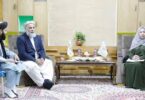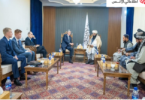Rod Nordland
KABUL: One of the many investigators of the American University in Afghanistan summed things up this way: If the United States government had paid to send every Afghan graduate to college in the United States, it would have spent less money than it did on financing a troubled, English-language university for them in the Afghan capital. The university graduated 1,281 Afghan degree students over the past decade, at a cost of $126,000 each to American taxpayers, or a total of $162 million.
Now the continued existence of the university is potentially at risk after investigators said they were unable to determine what happened to $63 million of that money, according to officials of the United States Agency for International Development and the Special Inspector General for Afghan Reconstruction. The result was an official effort last year by investigators at both agencies to have the university disqualified from receiving any further government funding, a process known as suspension or debarment.
A compromise was reached that temporarily prevented that step. But the university, generally known as A.U.A.F., remains the subject of a criminal investigation as well as a forensic audit to find out what happened to all that money. The university is one of the most high-profile development projects that the American government has undertaken in Afghanistan. Reached for comment, officials at USAID praised its academic achievements.
“The university’s primary objective is to provide an American-style education to the youth of Afghanistan, and it has been very successful at doing so,” said Tom Babington, an agency spokesman. “The student body is made up of impressive, motivated individuals, and its graduates are now increasingly influential in all areas of modern Afghan life — in both the public and private sectors.” Prestigious Fulbright fellowships have been awarded to 76 of its graduates, a higher number than any other university worldwide, according to A.U.A.F.
Mr. Babington acknowledged that the financial and management problems uncovered by investigators were serious, but he said that continued funding by the United States government, which underwrites most of the university’s budget, was still under discussion. “USAID is in negotiations with A.U.A.F. for a possible extension through June 2020,” he said.
The agency’s contract to fund the university expires on Friday, but there is interim funding until the end of June, Mr. Babington said. On March 29, the university’s board chairman, David Sedney, signed an administrative agreement that American government officials say they demanded. In it, the university pledges to undertake substantial reforms in budgeting, management and oversight as a condition of future government funding, but admits to no wrongdoing. The New York Times obtained a copy of the agreement.
The agreement, according to the USAID inspector general, Ann Calvaresi Barr, “imposes robust mechanisms to monitor and verify steps that A.U.A.F. must take to continue to be entrusted with taxpayer dollars.” The university has had a turbulent history, with numerous management changes, and, in August 2016, an attack by the Taliban that killed at least seven students and six guards. A few weeks before that attack, two professors at the university, an Australian and an American, were kidnapped by the Taliban’s Haqqani network; both remain in captivity.
Then last November, the university’s board chairman, an American entrepreneur named Abul Huda Farouki, abruptly resigned, shortly before his indictment on criminal charges connected with his company’s contract to supply food and logistics support to the American military in Afghanistan.
The special inspector for Afghanistan, as well as the inspector general’s office of USAID, said they opened a joint criminal investigation into the university several years ago after they had been approached by a whistle-blower. But they said they found the university’s records in such disarray that they were not able to make a criminal case against anyone.
Instead, last year, the investigators recommended suspension or debarment of the university from receiving future government funding. USAID instead decided on the administrative agreement, which investigators for both agencies said they agreed to reluctantly. Mr. Sedney, a former Defense Department official and former president of the university who took over as board chairman after Mr. Farouki’s departure, played down the investigators’ concerns.
“In the range of administrative agreements, ours is the mildest one. It’s a regulatory proceeding. We were not suspended, no finding of fraud, no financial wrongdoing or requirement to pay back any money,” he said. He also objected to officials’ characterization that the university had “lost more than $63 million since 2012,” as the special inspector for Afghanistan said in its latest report to Congress.
“A.U.A.F. has not ‘lost’ any money,” Mr. Sedney said. “A.U.A.F. is a nonprofit organization that has spent all the money it has received from the US government.” Mr. Sedney also said government inspectors had failed to visit the university campus or interview key officials, including himself. He said the record-keeping problems were the result of the Taliban attack on the university, which forced it to move abruptly to a new, highly fortified campus.
“We welcome Sigar or any other organization or individual to contact the university for a full, accurate description of what A.U.A.F. has produced through its responsible use of all funds it has received,” he said, referring to the special inspector general for Afghanistan.
Mr. Sedney said the university had built a serious institution, with classrooms, dormitories, laboratories, computing facilities and other physical assets that will benefit Afghanistan for decades to come. The report made no mention of these assets in the places where it discussed what the United States and Afghanistan have gained from the university’s existence, he said. The special inspector general, John Sopko, said that investigators from his office and USAID had examined 28 previous investigations and audits of the university. When they sought further information from the university about money that was unaccounted for, he said, they encountered resistance — even to a subpoena from his office, in one case.
“In seven years of investigating government contractors and grant recipients in Afghanistan, this is one of the worst-run programs I have ever seen,” Mr. Sopko said. When his agency said the university had lost $63 million, he said, it meant that record-keeping was so poor it was impossible to determine what had happened to that money, more than a third of the USAID and Defense Department grants to the university since it was founded in 2006.
“Suspension or debarment actions are serious. In the grant and aid world, that’s considered to be the death penalty,” Mr. Sopko said. “We really want this university to survive, but if it continues with this management style that everything is O.K. and there’s nothing to worry about, it will fail.” USAID officials said that future funding of the university depended on it making substantial progress under the administrative agreement. The USAID administrator, Mark Green, emphasized those concerns in a letter to Mr. Sedney on April 29, which the agency released.
“I remain concerned about the Board of Trustees’ commitment to the responsible management of US taxpayer dollars and dedication to making A.U.A.F. a self-reliant, sustainable institution,” Mr. Green said. The administrator said that if ongoing negotiations lead to an extension of university funding for another year, “this is the last such extension I will approve.” He added that any future funding would be subject to a competitive bidding process, meaning another organization might win the university funding.
Ms. Barr, the USAID inspector general, said her office would “remain vigilant in this matter. Time will tell if A.U.A.F.’s responses effectively address the serious nature of our concerns.” Mr. Sopko also said his agency was continuing its criminal investigation and an audit of how the university spent government funding. USAID officials acknowledge that spending at the university has been high.
“Any time you are starting up a new institution, the costs will be higher,” Mr. Babington said. “Afghans studying at institutions in Afghanistan are also more likely to maintain their local connections, look for local employment opportunities, and ultimately contribute to the Afghan economy and society. That remains our intent.” Mr. Sedney said the investigations of the university did not focus on its achievements. “The university’s academic program is in the best shape it’s been in its history,” he said. “The level of student achievement is higher than ever before.”
Courtesy: (The New York Times)






